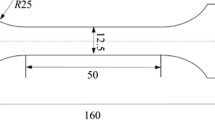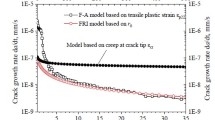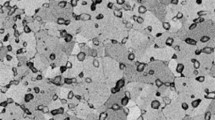Establishing a quantitative prediction model for the SCC crack growth rate of dissimilar metal welded joints at the safe end is very important for the safety evaluation of nuclear power structures. However, the SCC growth process is closely related to crack tip creep. In this paper, uniaxial tensile creep experiments under different stress are carried out on nickel base alloy 600, and the constitutive creep equation of nickel base alloy 600 is established. At the same time, the SCC crack tip creep field is analyzed using finite element software, and the effects of crack tip creep variables, creep rates, and material creep properties on the crack tip field are analyzed. Results show that nickel base alloy 600 occurs creep under high stress, and the creep rate in the crack tip region decreases with the crack inclination angle and the distance from the crack tip. The peak values of creep and creep rate appear directly in front of the crack propagation direction. Research results lay a foundation for establishing a quantitative prediction model of SCC.








Similar content being viewed by others
References
D. H. Du, Stress Corrosion Cracking Behavior and Crack Growth Rate Prediction of Cold Worked 316L Stainless Steel in Pressurized Water Reactor Primary Environments, Shanghai Jiaotong University (2017).
O. K. Chopra, W. J. Shack, “Overview of fatigue crack initiation in carbon and low alloy steels in light water reactor environments,” J Press Vess-T, 121, No. 1, 49–60 (1999).
R. Bashir, H. Xue, J. L. Zhang, et al., “Effect of material macrostructural parameters on quantitative stress corrosion cracking plastic zone using extended finite element method in welded joints for light water reactor environment,” Corrosion, 76, No. 9, 826–834(2020).
R. W. Staehle and Z. Fang, “Comments on a proposed mechanism of internal oxidation for alloy 600 as applied to low potential SCC,” in: Proc. of Ninth Int. Symp. on Environmental Degradation of Materials in Nuclear Power Systems–Water Reactors (New Portbeach, USA, 1999), John Wiley & Sons, Inc. (2013).
S. R. Shah, I. L. Pryce, T. B. St John, et al., “Effect of environmental corrosion on fatigue crack growth morphology: a detailed investigation of the boundary between fatigue and corrosion control regimes,” Adv Mater Res, 891-892, 278–285(2014).
J. Shi, B. Fekete, J. Wang, et al., “Customization of the coupled environment fracture model for predicting stress corrosion cracking in Alloy 600 in PWR environment,” Corros Sci, 139, 58–67(2018).
S. B. Farina, G. S. Duffo, and J. R. Galvele, “Effect of cations on stress corrosion cracking: Ag–40Cd alloy in silver ion aqueous solutions containing a variety of foreign cations,” Corros Sci, 49, No. 4, 1687–1695 (2007).
Y. Yi and G. S. Was, “Stress and temperature dependence of creep in Alloy 600 in primary water,” Metall Mater Trans A, 32, No. 10, 2553–2560 (2001).
Y. H. Cui and J. L. Zhang, “Research of SCC prediction model for 304 stainless steel in the high-temperature water environment,” Strength Mater, 53, No. 4, 573–581 (2021).
K. J. Stephenson and G. S. Was, “Crack initiation behavior of neutron irradiated model and commercial stainless steels in high temperature water,” J Nucl Mater, 444, Nos. 1–3, 331–341 (2014).
K. S. Raja and D. A. Jones, “Effects of dissolved oxygen on passive behavior of stainless alloys,” Corros Sci, 48, No. 7, 1623–1638 (2006).
GB/T 228.2-2015. Metallic Materials – Tensile Testing – Part 2: Method of Test at Elevated Temperature (2015).
GB/T2039-2012. Metallic Materials – Uniaxial Creep Testing Method in Tension (2012).
L. J. Dong, Q. J. Peng, E. H. Han, et al., “Microstructure and intergranular stress corrosion cracking susceptibility of a SA508-52M-316L dissimilar metal weld joint in primary water,” J Mater Sci Technol, 34, No. 8, 1281–1292 (2018).
ASTM E399-90, Annual Book of ASTM Standards, ASTM International (2002).
W. Ramberg and W. R. Osgood, Description of Stress–Strain Curves by Three Parameters, Technical Report Archive & Image Library, 902 (1943).
Acknowledgments
This work was financially supported by the Fundamental Research Funds for the Central Universities, CHD (300102252513), the Science and Technology Project of Shaanxi Market Supervision Administration (2021KY10), and the State Administration for Market Regulation Research Project (2022MK165).
Author information
Authors and Affiliations
Corresponding author
Additional information
Translated from Problemy Mitsnosti, No. 2, p. 117, March – April, 2023.
Rights and permissions
Springer Nature or its licensor (e.g. a society or other partner) holds exclusive rights to this article under a publishing agreement with the author(s) or other rightsholder(s); author self-archiving of the accepted manuscript version of this article is solely governed by the terms of such publishing agreement and applicable law.
About this article
Cite this article
Zhang, J.L., Jiang, Z.Y., Mu, S.Y. et al. Creep Property and Crack Tip Creep Field Analysis of Nickel Base alloy 600. Strength Mater 55, 384–390 (2023). https://doi.org/10.1007/s11223-023-00532-5
Received:
Published:
Issue Date:
DOI: https://doi.org/10.1007/s11223-023-00532-5




